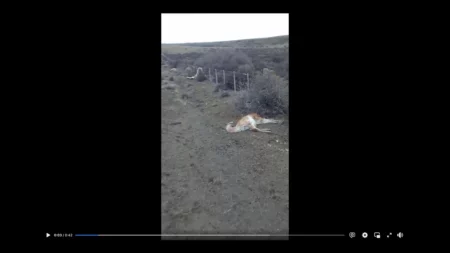If you only have a few seconds, read the following lines:
- The Santa Cruz provincial board of agriculture assured that 48 guanacos died after days of snow and frost in harsh weather conditions, but they did not die from bird flu.
- According to the Santa Cruz Caleta Olivia Environmental Secretariat, there are other videos of dead guanacos, but they correspond to 2020, which also died from heavy snowfall.
- Despite the recent detection of different cases of bird flu in the country, Senasa explained that there is no HPAI in Argentine poultry.
A video circulated on social networks, allegedly in the province of Santa Cruz, showing different deceased guanacos with audio stating that “they found 80 dead bodies by the side of the road” and that “they fell alone.” Additionally, the audio adds, “They left them because they were afraid of this bad flu, and they didn’t know if it was contagious,” referring to latest cases of Avian Influenza Sea lions in different regions of Argentina.
One of the videos on Facebook was accompanied by the following text: “A video and audio from where a dead guanaco was observed is related to an incident of bird flu on our shores.”
Santa Cruz guanacos didn’t die from bird flu
he Statement from the Santa Cruz Provincial Council of Agriculture (CAP) On August 28, they explained that three days earlier they had received a WhatsApp message containing images of various dead guanaco specimens near Paraje Lemarchand.
Thus, considering the pairs found in the community Recent Bird Flu Outbreaks in South American Fur SealsA team from CAP Animal Control traveled to the area to analyze the situation.
In this case, the statement insisted that 48 dead guanacos were indeed found, most of which showed signs of nutritional stress, possibly due to persistent snow and frost conditions over the past month.
Furthermore, he added: “Although there has been no history of avian influenza in camelids so far, we took samples to assess the presence of the disease in this species, bearing in mind that in addition to the many fatalities seen in 2020 In addition to the sample, due to the weather, in early August 2023, a dead guanaco was also found in the area near La Leona on National Highway 40.”
Finally, on Monday, September 4th, CAP conveyed SENASA processed guanaco samples “to assess for the presence of avian influenza and came back negative” and ensured that The deaths “came from starvation after several days of harsh weather conditions and snow and frost”.
Video Decontextualization
The day before the CAP statement, the Caleta Olivia Environmental Secretariat in Santa Cruz, people A post on Facebook reads: “Video circulated from yesterday, in which a mother-in-law or brother-in-law said it was bird flu, from 2020 when Erdogan had a lot of snow. El Calafate area” (sic ).
return A video went viralEnvironmental management graduate Victor Fratto’s X pointed out that the guanaco video is from 2020.
In any case, upon inquiry checkedCAP said they were unsure if the video was current or old.
Argentine bird flu
from Published by the National Produce Health and Quality Service (Senasa) Last detected August 29th positive case Highly pathogenic avian influenza (HPAI) H5 infection among sea lions of Rio Grande, Fuego; Punta Bermeja and San Antonio del Este Nature Reserves in Rionegro; Santa Cruz Loyo La Pointe; Puerto Piramides, Chubut; and Necochea, Mar del Plata, Clara Romeco, Balneario Mayor Blatovic and San Bla in Buenos Aires s.
Likewise, Senasa stressed that recent test results in marine mammals do not affect the animal health status self-declared to the World Organization for Animal Health (OMSA), and Argentina is considered free of HPAI in poultry.
return, As explained in this note checked, it is recommended not to handle dead animals or animals with suspicious symptoms. Likewise, producers, institutions, and the public are reminded that notification must be made if high mortality, neurological, digestive, and/or respiratory symptoms of susceptible species are found in wild birds or in commercial or backyard poultry.
Finally, it is advised not to travel to poultry farms or wildlife habitats after exposure to dead or symptomatic animals.
This check is Facebook’s third-party fact-checking program in Argentina. As far as photos and videos are concerned, we use fake images or images taken out of context, and always analyze images together with the text they are presented in.

